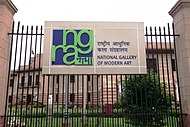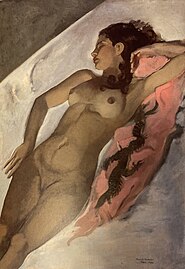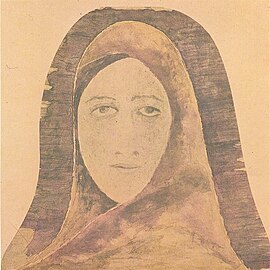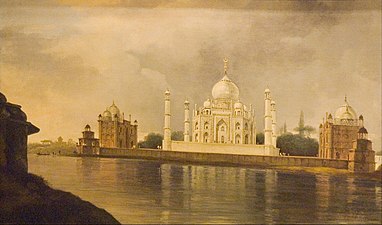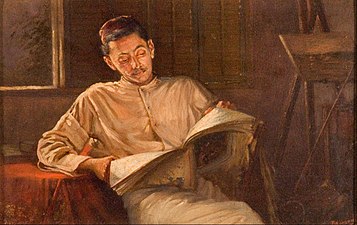
Ratan Parimoo, born in Kashmir, is an art historian, art educator, pedagogue, artist and former director of the Lalbhai Dalpatbhai Museum, Ahmedabad. Ratan Parimoo was one of the founder members of Baroda Group.

The Bengal School of Art, commonly referred as Bengal School, was an art movement and a style of Indian painting that originated in Bengal, primarily Kolkata and Shantiniketan, and flourished throughout the Indian subcontinent, during the British Raj in the early 20th century. Also known as 'Indian style of painting' in its early days, it was associated with Indian nationalism (swadeshi) and led by Abanindranath Tagore (1871–1951), but was also being promoted and supported by British arts administrators like E. B. Havell, the principal of the Government College of Art and Craft, Kolkata from 1896; eventually it led to the development of the modern Indian painting.
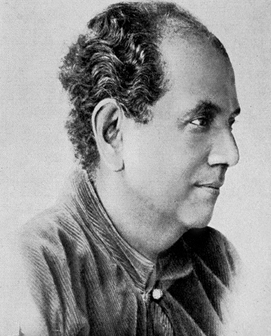
Abanindranath Tagore was the principal artist and creator of the "Indian Society of Oriental Art". He was also the first major exponent of Swadeshi values in Indian art. He founded the influential Bengal school of art, which led to the development of modern Indian painting. He was also a noted writer, particularly for children. Popularly known as 'Aban Thakur', his books Rajkahini, Buro Angla, Nalak, and Khirer Putul were landmarks in Bengali language children's literature and art.

Amrita Sher-Gil was a Hungarian-Indian painter. She has been called "one of the greatest avant-garde women artists of the early 20th century" and a pioneer in modern Indian art. Drawn to painting from an early age, Sher-Gil started formal lessons at the age of eight. She first gained recognition at the age of 19, for her 1932 oil painting Young Girls. Sher-Gil depicted everyday life of the people in her paintings.
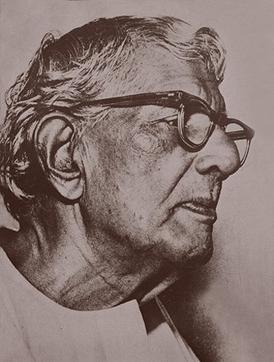
Jamini Roy was an Indian painter. He was honoured by the Government of India the award of Padma Bhushan in 1954. He remains one of the most famous pupils of Abanindranath Tagore, another praised Indian artist and instructor. Roy's highly simplified, flattened-out style, and reminiscent of European modern art was influenced by the “bazaar” paintings sold at Indian temples as talismans.

Nandalal Bose was one of the pioneers of modern Indian art and a key figure of Contextual Modernism.

The Lalit Kala Akademi or National Academy of Art (LKA) is India's national academy of fine arts. It is an autonomous organisation, established in New Delhi in 1954 by Government of India to promote and propagate understanding of Indian art, in and outside the country.

Ramkinkar Baij was an Indian sculptor and painter, one of the pioneers of modern Indian sculpture and a key figure of Contextual Modernism.
Pakala Tirumal Reddy (1915–1996) was an Indian artist. He was the fifth child born to Ram Reddy and Ramanamma at Annaram village, Karimnagar district, Telangana, India. He received his diploma in painting from J. J. School of Art, Bombay in 1939. He married Yashoda Reddy on 9 May 1947, and she completed a master's of art and Ph.D. degrees and authored over 22 compilations and novels.
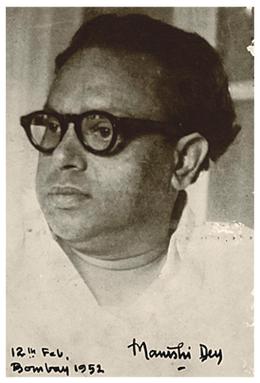
Manishi Dey was an Indian painter of the Bengal School of Art. Manishi Dey was the younger brother of Mukul Dey, a pioneering Indian artist and dry point etcher. Their two sisters, Annapura and Rani, were accomplished in arts and crafts as well.

The modern Indian art movement in Indian painting is considered to have begun in Calcutta in the late nineteenth century. The old traditions of painting had more or less died out in Bengal and new schools of art were started by the British. Initially, protagonists of Indian art such as Raja Ravi Varma drew on Western traditions and techniques including oil paint and easel painting. A reaction to the Western influence led to a revival in primitivism, called as the Bengal school of art, which drew from the rich cultural heritage of India. It was succeeded by the Santiniketan school, led by Rabindranath Tagore's harking back to idyllic rural folk and rural life. Despite its country-wide influence in the early years, the importance of the school declined by the 'forties' and now it is as good as dead.

Raman Siva Kumar, known as R. Siva Kumar, is an Indian contemporary art historian, art critic, and curator. His major research has been in the area of early Indian modernism with special focus on the Santiniketan School. He has written several important books, lectured widely on modern Indian art and contributed articles to prestigious international projects such as the Art Journal, Grove Art Online or The Dictionary of Art, Oxford University Press.
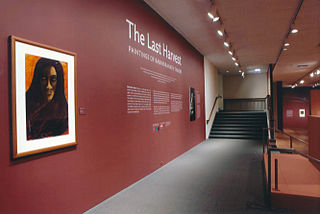
The Last Harvest was an exhibition of Rabindranath Tagore's paintings to mark the 150th anniversary of Tagore's birth. It was commissioned by the Ministry of Culture, India and organised with the National Gallery of Modern Art (NGMA). It consisted of 208 paintings drawn from the collections of Visva Bharati and the NGMA. The exhibition was curated by art historian R. Siva Kumar. Asia Art Archive later classified the exhibition as a "world event".

National Gallery of Modern Art is an art gallery in Bangalore. It was inaugurated in the year 2009. It showcases modern Indian art and houses paintings by Raja Ravi Verma, Jamini Roy, Amrita Sher-Gil, Rabindranath Tagore and a large number of modern and contemporary artists. Equipped with an auditorium, a public art reference library, a cafeteria, and a museum shop cum facilitation block, the NGMA Bengaluru looks ahead to becoming a hub of art activities and a major cultural centre at Bengaluru. The gallery organizes and hosts talks on art and culture by speakers, seminars, film screenings as well as workshops and guided walks throughout the year.

Kala Bhavana is the fine arts faculty of Visva-Bharati University, in Shantiniketan, India. It is an institution of education and research in visual arts, founded in 1919, it was established by Nobel laureate Rabindranath Tagore.
Santiniketan: The Making of a Contextual Modernism was an exhibition curated by R. Siva Kumar at the National Gallery of Modern Art in 1997, on the occasion of the 50th anniversary of India's Independence.

K. Venkatappa (1886–1965) was a pioneer painter, sculptor and an exponent of veena. He was born into a family of court painters in the princely state of Mysore, present day Karnataka. He was a pupil of Abanindranath Tagore. He was best known for his watercolors, with sensible realism. His Ootacamund watercolors reflect his independent vision.

Sunayani Devi was an Indian painter born into the aristocratic Tagore family in Calcutta, West Bengal. She was a self taught artist, with no academic training in art. Inspired by her brothers, Abanindranath Tagore, Gaganendranath Tagore, and Samarendranath Tagore, she started painting only at the age of 30. She was married at the age of 12 to the grandson of Raja Ram Mohan Roy.

Bireswar Sen (1897–1974) was an Indian painter, writer, and teacher, who was influenced by the Bengal School of Art and Western modernism, but then later developed a unique visual language of miniatures. He depicted grand landscapes, mostly featuring the Himalayas, on paintings measuring smaller than postcards. Sen was popular and celebrated during his lifetime, but faded from public consciousness after his death.


